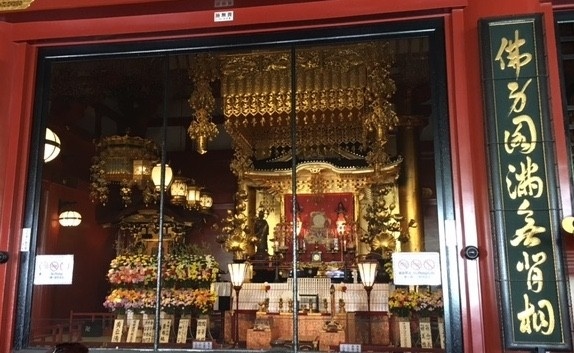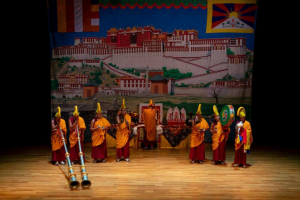
Japan’s most visited Buddhist temple is not one of the peaceful Zen temples, with their minimalist rock and gravel gardens, or even Todai-ji in Nara, with its giant Buddha statue housed in the world’s largest wooden structure. Instead, it is Senso-ji, located in northeastern Tokyo’s lively Asakusa district, that holds this record, welcoming about 30 million visitors annually. Dedicated to the bodhisattva Kannon (Skt: Avalokitesvara), Senso-ji was founded in the 7th century and is Tokyo’s oldest Buddhist temple. For much of its history, it was located adjacent to the city’s entertainment district, and even today it has a vibrancy that attests to its popularity, not only as a place of worship but also as a place to enjoy life.

According to the temple’s lore, its history dates back to 628, when two fishermen—the brothers Hinokuma Hamanari and Hinokuma Takenari—found a golden statue of Kannon floating in the Sumida River. Tokyo was just a village at that time, but the chief of the village, Hajino Nakamoto, recognized the sanctity of the statue and was so moved that he decided to remodel his own house into a small temple where the villagers could worship Kannon. He supposedly founded the temple in the year 645, which would make it not only the oldest temple in the capital, but also one of the oldest in the cluntry (Buddhism was introduced in Japan in the 6th century). Centuries later, Senso-ji became associated with the Tendai school of Buddhism, a Mahayana Buddhist tradition brought over from China in the 8th century that became the dominant form of Buddhism among Japan’s upper classes for many centuries. Japan’s military rulers and their samurai retainers generally favored meditational Buddhism (Zen Buddhism). However, when Tokugawa Ieyasu established the Tokyogawa shogunate, or military government, in Edo (now Tokyo) in 1603, he designated Senso-ji as the tutelary temple of the Tokugawa clan, bestowing it with valuable official support.
According to the temple’s lore, its history dates back to 628, when two fishermen—the brothers Hinokuma Hamanari and Hinokuma Takenari— found a golden statue of Kannon floating in the Sumida River. At that time, the current metropolis Tokyo was just a village, but the chief of the village—Hajino Nakamoto—recognized the sanctity of the statue and was so moved that he decided to remodel his own house into a small temple where the villagers could worship Kannon. He supposedly created the temple in the year 645, which would make it not only the oldest temple in the capital, but also one of the oldest in Japan (Buddhism was introduced in Japan in the 6th century). Centuries later, Sensoji became associated with the Tendai sect of Buddhism, a Mahayana Buddhist tradition, brought over from China in the 8th century, that became the dominant form of Buddhism among Japan’s upper classes for many centuries. Japan’s military rulers and their samurai retainers generally favored meditational Buddhism (Zen Buddhism). However, when Tokugawa Ieyasu established the Tokyogawa shogunate, or military government, in Edo (now Tokyo), in 1603, he designated Sensoji as the tutelary temple of the Tokugawa clan, bestowing it with valuable official support.

During the Edo or Tokugawa period (1603–1868), the culture of the city blossomed, particularly in the pleasure quarters of Yoshiwara located next to the temple, where theaters, restaurants, teahouses, and brothels were located. As a result, the temple was visited by people of all classes and backgrounds, much like the neighboring Asakusa Shrine, a Shinto complex where the spirits (kami) of the Hinokuma brothers and Chief Hajino are housed and worshipped. Edoites embraced the concept of the “floating world” (ukiyo), which finds its origins in the Buddhist belief in the transitory, fleeting nature of life, and interprets it as “living every moment as if it is your last.” This motto reverberated in the adjacent pleasure quarters, but also during visits to temples such as Senso-ji. The temple was such a prominent feature in the city’s life that it was depicted by renowned woodblock print (ukiyo-e) artists such as Utagawa Hiroshige (1797–1858) and Toyota Hokkei (1780–1850).
Although most of the original temple buildings were destroyed by US bombs during World War II, the temple was rebuilt soon afterwards. Today, the complex resembles the Edo-period site, with several imposing gates, including the Thunder Gate (Kaminari-mon), with its iconic giant red lantern, and a five-story pagoda. At the heart of the complex is the main worship hall (honden), where worshippers come to pray to the statue of Kannon. Although the statue was originally displayed in the temple, today it is a “secret Buddha” (hibutsu) after an itinerant priest announced that Kannon had come to him in a dream and requested that the statue be hidden. Today, visitors pray before a gilded altar that contains a screen, behind which the statue is housed.

Senso-ji functions as a place of worship for practicing Buddhists in the local community, but today the majority of its many visitors are tourists, especially from other Asian countries such as China and India. Guides shout politely to herd their tour groups through the crowds that pour through the gates and up and down the steps of the main buildings. Many visitors stop to light incense and bathe in its smoke, before heading towards Nakamise, a long row of stalls selling sweets and souvenirs. It is difficult to traverse the complex without being jostled several times, particularly during cherry blossom season, when tourists turn their attention to the blossoming trees nearby.
The atmosphere of this temple is certainly not one of serenity. However, the temple is filled with a cheerful, light-hearted energy—one that recalls earlier times when Senso-ji provided a respite for the people of Edo from the difficulties of daily life. Makiko Kumazawa, a seasoned tour guide based in Tokyo, has a deep appreciation for this aspect of Senso-ji’s history. “There were many restrictions on the lives of the people of Edo. They were not allowed to travel freely because the government imposed many strict laws, but they were allowed to visit temples on pilgrimages, so many people visited Senso-ji and other local temples to enjoy themselves.” One of the principal goals of Buddhist practice is non-attachment. With its crowds, noise, and enticing shops, Senso-ji, in its own way, continues to provide the residents of Tokyo and visitors alike an opportunity to let go of all kinds of worries and restraints in their daily lives—offering a lively alternative to the tranquility of a Zen temple garden.














